- Opera d’Oro: A New Budget Opera
Label
-
-
- Opera d’Oro is
Allegro Distribution’s new budget line of opera recordings
formerly only available at top prices from pirate labels. Despite
shoddy notes in English only (plot synopsis, no libretto), the
first batch of nine releases shows great promise. Treasurable is
the 1969 Italian Radio and Television Orchestra studio broadcast
of Rossini’s comic L’Italiana in Algeri (OPD-1146),
previously available at double the price on Pantheon. The recorded
sound is superb and the top notch cast includes Teresa Berganza’s
agile, darkly Mediterranean Isabella, Alvino Misciano’s naturally
high and flexible Lindoro, and Mario Petri’s rich, solid Mustafá.
Buffo bass Sesto Bruscantini is incomparable as Taddeo. Maestro
Sanzogno conducts slowly enough that one can savour the libretto’s
charming absurdities, and the whole production radiates Italianate
authenticity. A 1964 live La Scala Turandot (OPD-1152)
features heroic Birgit Nilsson, splendidly robust Franco Corelli,
and the redoubtable Galina Vishnevskaya. The Russian soprano’s Liu
is Slavic and not very vulnerable, but she’s the Italian
audience’s favorite. Ping, Pang and Pong are lyrical and
well-matched. This is a night of great singing, with cries of
"Bravo" and "Bis", but due to considerable crackle, audiophiles
will prefer the Nilsson/Corelli studio version (EMI).
Philip Anson
-
-
- Comprendre la musique baroque à
travers ses formes
- Raphaëlle Legrand
- Collection Passerelles (harmundia mundi HMB
590001.02)
-
-
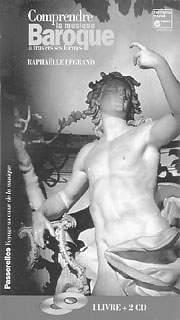 Dans ce livre (64 p.) de vulgarisation
musicologique, qui inclut deux CD au minutage généreux, Raphaëlle
Legrand fournit des clés formelles pour permettre à l'amateur de
musique baroque d'ajouter au plaisir d'écouter celui de
comprendre. Pour illustrer son propos, elle a recours à de
nombreux tableaux synoptiques, extraits de partitions et analyses
structurelles souvent dotées de notations temporelles, qui
facilitent l'identification des passages sur les CD. Dans ce livre (64 p.) de vulgarisation
musicologique, qui inclut deux CD au minutage généreux, Raphaëlle
Legrand fournit des clés formelles pour permettre à l'amateur de
musique baroque d'ajouter au plaisir d'écouter celui de
comprendre. Pour illustrer son propos, elle a recours à de
nombreux tableaux synoptiques, extraits de partitions et analyses
structurelles souvent dotées de notations temporelles, qui
facilitent l'identification des passages sur les CD.
- Dans un premier temps, les formes musicales à grande échelle
(opéra, sonates, musique religieuse, etc.) sont étudiées. Ensuite,
une analyse plus détaillée permet de classifier les formes fixes,
continues et contrapuntiques (illustrées par les 25 exemples
musicaux du CD 2). Dans la troisième partie, la perspective est
renversée : il ne s'agit plus de cataloguer les formes de l'époque
baroque en s'appuyant sur des citations musicales, mais plutôt de
partir de l'oeuvre elle-même et de l'analyser systématiquement.
L'auteur a retenu à cet effet, sur le CD 1, trois oeuvres
complètes (une sonate pour violon de Corelli, un Concert
Royal de Couperin et une cantate de Bach) ainsi que le
premier acte de l'Orfeo de Monteverdi.
- S'il est vrai que certaines analyses, plutôt pointues,
risquent de dérouter quelque peu le néophyte, l'ouvrage dans son
ensemble est tout à fait accessible au mélomane moyen. Une belle
iconographie, des graphiques clairs, en couleurs, une disposition
aérée et un glossaire élaboré témoignent par ailleurs du sérieux
et de la qualité de l'ouvrage et en facilitent la compréhension.
- Enfin, les 2 CD puisent dans un catalogue nourri par plusieurs
étoiles de la musique baroque, au premier rang desquels il faut
citer William Christie, René Jacobs, Philippe Herreweghe et
Kenneth Gilbert. Rodrigue Audet
-
-
-
- Songs of Free Men
- Paul Robeson, baritone
- Sony MHK 63223
-
-
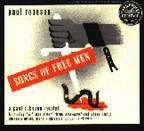 This highly recommended Sony Masterworks
Heritage reissue appears just in time for the centenary of Paul
Robeson’s birth (April 1898-1998). Sony’s 71-minute program
gathers portions of three Columbia Masterworks 78 rpm records
(Songs of Free Men,1942, Spirituals, 1945, A
Robeson Recital of Popular Favourites, 1947). From the first
two albums we have the leftist labour anthem, "Joe Hill", the
Spanish loyalist song, "The Four Insurgent Generals", a Nazi
concentration camp song, several Russian folksongs, "By and By",
"Motherless Child" and the famous "Water Boy." All of these are
also included on a recent Pearl release called "Songs for Free
Men" but Sony’s sound is far preferable, being remastered from the
original sources. The Pearl disc includes rare but tedious Chinese
revolutionary songs and the chauvinistic "Ballad for Americans."
Sony’s popular songs include eight of Norman Lockwood’s schmaltzy
arrangements of Uncle Tom spirituals and show tunes (yes, "Ol Man
River" and "I Still Suits Me") that Robeson would later
understandably refuse to sing. These cloying arrangements can
never compare to the sheer electricity and camp of Robeson’s
original soundtracks from the 1930s -- best heard on "Paul Robeson
and Elizabeth Welch: Songs From their Films" (Movie Stars CMSCD
011) and the two volumes of Robeson’s British recordings on Great
Voices of the Century (Memoir Classics CDMOIR 415 & 426),
available in Canada through Pelleas Distribution. The Sony disc
also includes the first CD release of Robeson’s Hasidic chant and
aria from Mendelssohn’s Elijah. For content and sound
quality, Sony’s Songs of Free Men is the best single
Robeson disc on the market. This highly recommended Sony Masterworks
Heritage reissue appears just in time for the centenary of Paul
Robeson’s birth (April 1898-1998). Sony’s 71-minute program
gathers portions of three Columbia Masterworks 78 rpm records
(Songs of Free Men,1942, Spirituals, 1945, A
Robeson Recital of Popular Favourites, 1947). From the first
two albums we have the leftist labour anthem, "Joe Hill", the
Spanish loyalist song, "The Four Insurgent Generals", a Nazi
concentration camp song, several Russian folksongs, "By and By",
"Motherless Child" and the famous "Water Boy." All of these are
also included on a recent Pearl release called "Songs for Free
Men" but Sony’s sound is far preferable, being remastered from the
original sources. The Pearl disc includes rare but tedious Chinese
revolutionary songs and the chauvinistic "Ballad for Americans."
Sony’s popular songs include eight of Norman Lockwood’s schmaltzy
arrangements of Uncle Tom spirituals and show tunes (yes, "Ol Man
River" and "I Still Suits Me") that Robeson would later
understandably refuse to sing. These cloying arrangements can
never compare to the sheer electricity and camp of Robeson’s
original soundtracks from the 1930s -- best heard on "Paul Robeson
and Elizabeth Welch: Songs From their Films" (Movie Stars CMSCD
011) and the two volumes of Robeson’s British recordings on Great
Voices of the Century (Memoir Classics CDMOIR 415 & 426),
available in Canada through Pelleas Distribution. The Sony disc
also includes the first CD release of Robeson’s Hasidic chant and
aria from Mendelssohn’s Elijah. For content and sound
quality, Sony’s Songs of Free Men is the best single
Robeson disc on the market.
-
-
- Ninon Vallin, The Complete Pathé Art
Recordings (1927-1929)
- Marston 52006-2
-
-
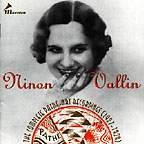 La compagnie Marston a déjà fait paraître
plusieurs classiques, dont une Manon de Massenet fort
impressionnante, mais le coffret double consacré aux
enregistrements Pathé de la soprano Ninon Vallin est possiblement
sa plus belle réussite. Ninon Vallin a représenté l’essence même
du chant français pendant presque 40 ans. Elle a débuté sur scène
aux environs de 1911 dans La demoiselle élue de Debussy et
chantait encore en concert en 1950. Elle a d’ailleurs enregistré
ses derniers disques en 1956, cinq ans avant sa mort, à l’âge de
75 ans. On retrouve ici les 43 titres qu’elle a enregistrés pour
la compagnie Pathé entre 1927 et 1929. Principalement voué à
l’opéra français (les Manon, Thaïs et Louise
de nos rêves !) et l’opéra italien (Tosca, La
bohème et Madame Butterfly), ce coffret est tout
simplement indispensable à ceux et celles qui cherchent à
retrouver ou à connaître la véritable tradition du chant français.
La voix de Ninon Vallin n’était peut-être pas la plus belle, mais
certainement la plus distinctive de son époque. Ses disques,
malgré le processus inégal de Pathé, témoignent de son génie. Elle
pouvait simultanément illuminer le texte avec le lyrisme et la
musicalité de son approche, et rendre la ligne vocale encore plus
séduisante grâce à une diction irréprochable. Son art baignait
dans la subtilité et l’intelligence, et elle couronnait le tout
avec une technique qui lui permettait d’interpréter avec
sensibilité non seulement les personnages de Manon et de
Marguerite, mais aussi de Carmen et de Charlotte. Richard
Turp La compagnie Marston a déjà fait paraître
plusieurs classiques, dont une Manon de Massenet fort
impressionnante, mais le coffret double consacré aux
enregistrements Pathé de la soprano Ninon Vallin est possiblement
sa plus belle réussite. Ninon Vallin a représenté l’essence même
du chant français pendant presque 40 ans. Elle a débuté sur scène
aux environs de 1911 dans La demoiselle élue de Debussy et
chantait encore en concert en 1950. Elle a d’ailleurs enregistré
ses derniers disques en 1956, cinq ans avant sa mort, à l’âge de
75 ans. On retrouve ici les 43 titres qu’elle a enregistrés pour
la compagnie Pathé entre 1927 et 1929. Principalement voué à
l’opéra français (les Manon, Thaïs et Louise
de nos rêves !) et l’opéra italien (Tosca, La
bohème et Madame Butterfly), ce coffret est tout
simplement indispensable à ceux et celles qui cherchent à
retrouver ou à connaître la véritable tradition du chant français.
La voix de Ninon Vallin n’était peut-être pas la plus belle, mais
certainement la plus distinctive de son époque. Ses disques,
malgré le processus inégal de Pathé, témoignent de son génie. Elle
pouvait simultanément illuminer le texte avec le lyrisme et la
musicalité de son approche, et rendre la ligne vocale encore plus
séduisante grâce à une diction irréprochable. Son art baignait
dans la subtilité et l’intelligence, et elle couronnait le tout
avec une technique qui lui permettait d’interpréter avec
sensibilité non seulement les personnages de Manon et de
Marguerite, mais aussi de Carmen et de Charlotte. Richard
Turp
-
-
- Aria: Opera Arias Arranged For
Clarinet
- Richard Stoltzman, clarinet
- Slovak Philharmonic Orchestra
- RCA Red Seal 09026-68817-2 / BMG
-
-
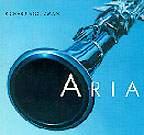 Richard Stoltzman has transcribed eighteen
of the most popular opera arias from La Bohème, Faust, Porgy
and Bess, La Traviata, etcetera for B flat and A clarinet,
which he plays with mind-boggling virtuosity and tongue-in-cheek
humour. The idea sounds kitschy but playing this good is no joke.
His sheer brilliance leaves one breathless with admiration. A real
treat for clarinetists, opera lovers, and fans of the bizarre.
Richard Stoltzman joins the Toronto Symphony Orchestra May 25,
26, 27, 1998. Tel: 416-593-4828. www.tso.on.ca. Richard Stoltzman has transcribed eighteen
of the most popular opera arias from La Bohème, Faust, Porgy
and Bess, La Traviata, etcetera for B flat and A clarinet,
which he plays with mind-boggling virtuosity and tongue-in-cheek
humour. The idea sounds kitschy but playing this good is no joke.
His sheer brilliance leaves one breathless with admiration. A real
treat for clarinetists, opera lovers, and fans of the bizarre.
Richard Stoltzman joins the Toronto Symphony Orchestra May 25,
26, 27, 1998. Tel: 416-593-4828. www.tso.on.ca.
-
-
-
-
-
- Vivaldi Motets for
Soprano
- Karina Gauvin, soprano / Les Chambristes de
Ville-Marie
- Analekta FL 23099
-
-
- For her latest release, Montreal soprano Karina Gauvin records
a selection of Vivaldi’s solo vocal works with Les Chambristes de
Ville-Marie, a group founded and directed by her husband. Gauvin’s
delightful sense of musicality sculpts a great deal out of the
rather ordinary material. Fine moments on this disc include the
"Sit nomen domini" from the Laudate Pueri with its
suspensions over the pulsing string accompaniment - an effective
Vivaldi-ism often copied by Handel during his Roman years.
Gauvin’s warm and compelling middle range easily manages the
intricate coloratura. Her phrasing is natural and shapely
throughout. She tackles the demanding "Sum in medio tempestatum"
and its "Alleluia" without breaking a sweat. Gauvin’s otherwise
charming voice sometimes betrays her the few times she goes above
the staff. Her high notes can sound tight and reedy (in the
opening of "O qui coeli", for example). Also, she uses much white
tone, deadening her otherwise lovely spin. The sound on this
recording is wonderfully intimate, with the ensemble present and
clear. Peter Phoa
-
-
- Wings in the Night: Swedish
Songs
- Anne Sofie von Otter, mezzo. Bengt Forsberg,
piano
- Deutsche Grammophon 449-189-2
-
-
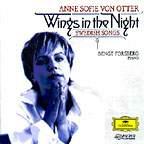 Swedish mezzo Anne Sofie von Otter has
recently recorded everything from baroque arias to French
mélodies. I still find this album of Swedish songs her most
enjoyable. The generous 67-minute program samples the cream of
romantic Swedish art song between 1884 and 1924. Unlike the dreary
Russian songs of the same period, these Swedish lyrics are folksy,
pastoral, and festive, and the influence of Grieg, Schubert and
Richard Strauss is predominant. The programmatic and onomatopoeic
songs like Stenhammer’s "Mood Pictures" display considerable
originality and invention. Here Von Otter sounds her best, with a
creamy, soothing timbre: what a joy when words and music are so
beautifully matched. Anne Sofie von Otter in recital at
Toronto’s Ford Centre May 1, 1998. Tel: 416-872-2222. Swedish mezzo Anne Sofie von Otter has
recently recorded everything from baroque arias to French
mélodies. I still find this album of Swedish songs her most
enjoyable. The generous 67-minute program samples the cream of
romantic Swedish art song between 1884 and 1924. Unlike the dreary
Russian songs of the same period, these Swedish lyrics are folksy,
pastoral, and festive, and the influence of Grieg, Schubert and
Richard Strauss is predominant. The programmatic and onomatopoeic
songs like Stenhammer’s "Mood Pictures" display considerable
originality and invention. Here Von Otter sounds her best, with a
creamy, soothing timbre: what a joy when words and music are so
beautifully matched. Anne Sofie von Otter in recital at
Toronto’s Ford Centre May 1, 1998. Tel: 416-872-2222.
-
-
-
- Trombone Concerti: Albrechtsberger,
Wagenseil, Mozart, Haydn
- Alain Trudel, trombone / Northern
Sinfonia
- Naxos 8.553831
-
-
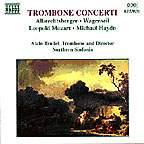 At last, Quebec trombonist Alain Trudel’s
first solo album. The four classical concertos recorded here date
from about 1755 to 1770 and represent just about the entire
pre-modern trombone concerto repertory. Only the Wagenseil and
Albrechtsberger were written as concerts per se. Leopold
Mozart’s "concerto" is extracted from the last three movements of
his Serenata (1756). Alain Trudel has assembled Michael
Haydn’s Concerto from a Divertimento (1764). All
these works display the expected Hausmusik virtues of calm
stateliness. The trombone’s part is very demure, approaching the
French horn (a century before Wagner’s "Ride of the Valkyries").
The Northern Sinfonia, a chamber orchestra with harpsichord
continuo, led by Trudel himself, play and record very well. This
album is easy listening in the best sense. Alain Trudel and his
ensemble play at Ottawa’s National Arts’ Centre on May 24. At last, Quebec trombonist Alain Trudel’s
first solo album. The four classical concertos recorded here date
from about 1755 to 1770 and represent just about the entire
pre-modern trombone concerto repertory. Only the Wagenseil and
Albrechtsberger were written as concerts per se. Leopold
Mozart’s "concerto" is extracted from the last three movements of
his Serenata (1756). Alain Trudel has assembled Michael
Haydn’s Concerto from a Divertimento (1764). All
these works display the expected Hausmusik virtues of calm
stateliness. The trombone’s part is very demure, approaching the
French horn (a century before Wagner’s "Ride of the Valkyries").
The Northern Sinfonia, a chamber orchestra with harpsichord
continuo, led by Trudel himself, play and record very well. This
album is easy listening in the best sense. Alain Trudel and his
ensemble play at Ottawa’s National Arts’ Centre on May 24.
-
-
- Jean Jacques Rousseau : Le Devin du
Village
- Louis de Froment / Orchestre de Chambre Louis
de Froment
- Naxos CPO 999 559-2
-
-
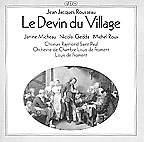 Même quand on sait que
Jean-Jacques Rousseau a composé un opéra, on ne reconnaît pas
toujours toute l'importance de cette oeuvre qui a transformé la
sensibilité de l'époque et amené l'éclosion d'un genre musical
nouveau -- l'opéra-comique -- genre auquel, paradoxalement, elle
n'appartient pas elle-même. Même quand on sait que
Jean-Jacques Rousseau a composé un opéra, on ne reconnaît pas
toujours toute l'importance de cette oeuvre qui a transformé la
sensibilité de l'époque et amené l'éclosion d'un genre musical
nouveau -- l'opéra-comique -- genre auquel, paradoxalement, elle
n'appartient pas elle-même.
- Le Devin du Village n'est pas un opéra-comique à proprement
parler, car il comporte des récitatifs au lieu de dialogues
parlés. Pour le reste, il présente les deux autres
caractéristiques essentielles du genre, soit une musique marquée
au sceau d'une élégante simplicité et une intrigue sentimentale
(la réconciliation amoureuse d'un couple paysan) propre à plaire
aux classes moyennes.
- La simplicité même du Devin l'a parfois fait taxer de
niaiserie, mais le jugement ne pourrait être plus injuste.
L'oeuvre remporta un énorme succès dès sa première, en 1752, et ce
fut un succès durable, car elle est demeurée au répertoire pendant
près de 70 ans. Même son livret a été beaucoup imité : l'argument
de Bastien und Bastienne de Mozart en dérive directement,
de même que celui de Colas et Colinette de Quesnel, le tout
premier opéra composé au Canada, et créé à Montréal en 1790.
- Quant à la
musique, cet excellent enregistrement, tiré (enfin!) des voûtes
d'EMI, en fait ressortir les réels mérites. Rousseau s'y révèle un
mélodiste de talent (la romance «Dans ma cabane obscure» est un
morceau d'anthologie) et un dramaturge lyrique aux conceptions
esthétiques d'une cohérence remarquable. La naïveté de
l'orchestration est plus que largement compensée par le traitement
expert des voix, non seulement dans les airs et les ensembles,
mais aussi dans les récitatifs d'un naturel étonnant. Les parties
vocales sont si soignées que les chanteurs, parmi les meilleurs de
l'époque, n'ont aucune peine à énoncer chaque mot avec une
parfaite intelligibilité -- tant mieux, car CPO n'a pas jugé bon
d'inclure un livret. L'enregistrement est un peu dur et
réverbérant. Par ailleurs, comme il a été originellement conçu
pour une édition sur disque 33 tours, il comporte des coupures
(notamment dans le «vaudeville» de la scène finale).
Pierre Marc
Bellemare
-
-
- Franz Liszt: A Faust
Symphony
- Iván Fischer / Budapest Festival
Orchestra
- Philip 454-460-2, 73.45 mins. DDD.
-
-
- Several superb recordings of Liszt’s A Faust Symphony in
Three Character Portraits (depicting Faust, Gretchen, and
Mephistopheles) exist but this is the first time the two
alternative endings have been included on the same disc. You can
program either Liszt’s original instrumental ending (1854) or the
longer, more famous Chorus Mysticus (1857). This is Iván Fischer’s
third critically acclaimed recording with the Budapest Festival
forces (the Hungarian Rhapsodies are to come). The orchestra has
notably fine wind, brass and string players. Their rapport with
Fischer is total. His precise and cerebral reading is admirable
but perhaps not the best way to convey Liszt’s melodrama. Tenor
Hans Peter Blochwitz’s brief solo is adequate. The recorded sound
in Budapest’s famous Italian Institute is detailed, balanced and
crystal clear but a bit distant compared to older recordings.
-
-
- Renée Fleming : Mozart Arias
- Sir Charles Mackerras / Orchestra of St.
Luke's (London 452-602-2)
- Renée Fleming : Signatures -- Great
Opera Scenes
- Sir Georg Solti / London Symphony Orchestra
(London 455-760-2)
- Renée Fleming : The Beautiful
Voice
- Jeffrey Tate / English Chamber Orchestra
(London 289-458-858-2)
-
-
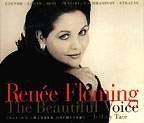 It is no news that American soprano Renée
Fleming has a gorgeous voice. Her discs of Strauss’s Four Last
Songs (RCA Red Seal 09026-68539-2) and of Mozart arias were
ravishing. Signatures, her disc of opera scenes, conducted
by the late Sir Georg Solti was full of wonderful things (the
Letter Scene from Tchaikovsky’s Eugene Onegin, Rusalka’s
"Song to the Moon", the Willow Song from Otello, the
embroidery scene from Peter Grimes). But in "Dove sono" one
noticed the intrusion of an unpleasant vibrato on high, loud
notes, and a tendency to whimper when expressing emotion. Now
The Beautiful Voice confirms these annoying habits. In
"Depuis le jour", even though the orchestra is held back, Fleming
still whimpers on "Je suis heureuse!", has gutteral low notes, and
aspirates Manon’s "Je suis be-he-he-elle!" What conclusions to
draw? First of all, recordings exaggerate Fleming’s flaws. She is
always better live than on disc. She doesn’t have much affinity
for the French, Italian, Hungarian or Spanish repertoire (her
Rachmaninov Vocalise is fine, but her "Epilogo" by Spanish
pop singer José María Cano is awful). On the other hand her German
stuff still sounds wonderful (Korngold, R. Strauss). So try
Fleming’s Strauss Four Last Songs, Mozart Arias, and
Signatures album to hear the best of her beautiful voice. It is no news that American soprano Renée
Fleming has a gorgeous voice. Her discs of Strauss’s Four Last
Songs (RCA Red Seal 09026-68539-2) and of Mozart arias were
ravishing. Signatures, her disc of opera scenes, conducted
by the late Sir Georg Solti was full of wonderful things (the
Letter Scene from Tchaikovsky’s Eugene Onegin, Rusalka’s
"Song to the Moon", the Willow Song from Otello, the
embroidery scene from Peter Grimes). But in "Dove sono" one
noticed the intrusion of an unpleasant vibrato on high, loud
notes, and a tendency to whimper when expressing emotion. Now
The Beautiful Voice confirms these annoying habits. In
"Depuis le jour", even though the orchestra is held back, Fleming
still whimpers on "Je suis heureuse!", has gutteral low notes, and
aspirates Manon’s "Je suis be-he-he-elle!" What conclusions to
draw? First of all, recordings exaggerate Fleming’s flaws. She is
always better live than on disc. She doesn’t have much affinity
for the French, Italian, Hungarian or Spanish repertoire (her
Rachmaninov Vocalise is fine, but her "Epilogo" by Spanish
pop singer José María Cano is awful). On the other hand her German
stuff still sounds wonderful (Korngold, R. Strauss). So try
Fleming’s Strauss Four Last Songs, Mozart Arias, and
Signatures album to hear the best of her beautiful voice.
-
-
- Alexander Zemlinsky: Die Seejungfrau
/ Psalms 13 & 23
- Riccardo Chailly / RSO Berlin
- London 444-969-2
-
-
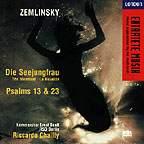 The latest in London/Decca’s Entartete
Musik (Music Suppressed by the Third Reich) series adds another
version of Zemlinsky’s Mermaid to the discography. The
first movement of this symphonic poem was identified only in 1984,
and the piece was then given its first complete modern
performance. Zemlinsky’s program follows Hans-Christian Anderson’s
fairy tale of the little mermaid who moves from the ocean to the
human world where she is shipwrecked, rescued by a prince, and
transformed by the Sea Witch into a woman. The ravishing
orchestral writing blends shamelessly Straussian sentimentality
and brooding Wagnerian mysticism. Ethereal strings and ominous
horns depict the throbbing pulse of the sea’s tidal movements. The
gripping conflict between the mermaid’s optimistic love and her
tragic destiny is palpable. Chailly and his orchestra give a
hearty performance full of grand effects, with excellent flute and
violin solos. Nevertheless, I recommend the more atmospheric and
magical 1988 recording by Sinfonieorchester der Südwestfunks,
Baden-Baden (Wergo 286-209-2) -- if you can find it. The latest in London/Decca’s Entartete
Musik (Music Suppressed by the Third Reich) series adds another
version of Zemlinsky’s Mermaid to the discography. The
first movement of this symphonic poem was identified only in 1984,
and the piece was then given its first complete modern
performance. Zemlinsky’s program follows Hans-Christian Anderson’s
fairy tale of the little mermaid who moves from the ocean to the
human world where she is shipwrecked, rescued by a prince, and
transformed by the Sea Witch into a woman. The ravishing
orchestral writing blends shamelessly Straussian sentimentality
and brooding Wagnerian mysticism. Ethereal strings and ominous
horns depict the throbbing pulse of the sea’s tidal movements. The
gripping conflict between the mermaid’s optimistic love and her
tragic destiny is palpable. Chailly and his orchestra give a
hearty performance full of grand effects, with excellent flute and
violin solos. Nevertheless, I recommend the more atmospheric and
magical 1988 recording by Sinfonieorchester der Südwestfunks,
Baden-Baden (Wergo 286-209-2) -- if you can find it.
-
-
- Chansons et Danses
- Jacques Lacombe / Les Vents de
Montréal
- CBC MVCD 1105
-
-
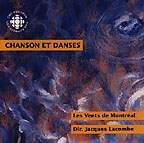 The chamber ensemble Les Vents de Montréal
unites first-chair players from the Montreal Symphony Orchestra
and the Orchestre Métropolitain to play new compositions and
arrangements for wind instruments. This recording contains six
works by D’Indy, Farkas, Prinz, Regner, Uhl, and Srebotnjak -- all
accessible, atmospheric, pastoral works studded with folk dances
and rhythms. With the likes of oboist Ted Baskin, flutist Tim
Hutchins and French horn player James Sommerville, the playing is
predictably world class. This album is marvelously polished from
start to finish, enjoyable listening anywhere, anytime. The chamber ensemble Les Vents de Montréal
unites first-chair players from the Montreal Symphony Orchestra
and the Orchestre Métropolitain to play new compositions and
arrangements for wind instruments. This recording contains six
works by D’Indy, Farkas, Prinz, Regner, Uhl, and Srebotnjak -- all
accessible, atmospheric, pastoral works studded with folk dances
and rhythms. With the likes of oboist Ted Baskin, flutist Tim
Hutchins and French horn player James Sommerville, the playing is
predictably world class. This album is marvelously polished from
start to finish, enjoyable listening anywhere, anytime.
-
-
-
-
- Alfred Schnittke : Concerto grosso
No. 1
- Arvo Pärt : Tabula rasa
- Henry Gorecki : Concerto for
Harpsichord and Strings
- Yuli Turovsky / I Musici de Montréal
- Chandos CHAN 9590 / SRI
-
-
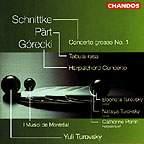 Cet excellent disque nous propose une brève
incursion du côté de l’Europe de l’Est en nous présentant trois
oeuvres interprétées de façon magistrale par l’ensemble
montréalais I Musici. En guise d’introduction, le sublime
Concerto grosso no 1 du polonais Alfred Schnittke nous
transporte dans un univers trouble où les genres les plus opposés
se côtoient. Fidèle à son titre, la Tabula rasa de Pärt
marque quant à elle un changement radical dans l’esthétique de ce
compositeur estonien. De style néoclassique, l’oeuvre dévoile un
discours musical à la fois riche et intimiste. N’étant pas en
reste, Gorecki fait preuve d’un caractère fougueux et passionné
avec son Concerto. L’utilisation du harpsicorde et de
motifs répétitifs tendent à créer un climat parfois tendu, voire
même extatique. Un disque de grande qualité dont les
inconditionnels de musique du XXe siècle se réjouiront.
Jean-Claude Thériault Cet excellent disque nous propose une brève
incursion du côté de l’Europe de l’Est en nous présentant trois
oeuvres interprétées de façon magistrale par l’ensemble
montréalais I Musici. En guise d’introduction, le sublime
Concerto grosso no 1 du polonais Alfred Schnittke nous
transporte dans un univers trouble où les genres les plus opposés
se côtoient. Fidèle à son titre, la Tabula rasa de Pärt
marque quant à elle un changement radical dans l’esthétique de ce
compositeur estonien. De style néoclassique, l’oeuvre dévoile un
discours musical à la fois riche et intimiste. N’étant pas en
reste, Gorecki fait preuve d’un caractère fougueux et passionné
avec son Concerto. L’utilisation du harpsicorde et de
motifs répétitifs tendent à créer un climat parfois tendu, voire
même extatique. Un disque de grande qualité dont les
inconditionnels de musique du XXe siècle se réjouiront.
Jean-Claude Thériault
-
-
- Schumann: Liederkreis, Op. 24.
Dichterliebe, Op. 48
- Ian Bostridge, tenor
- EMI 5565752
-
-
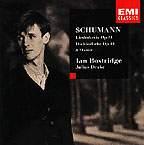 English tenor Ian Bostridge’s early
Hyperion recordings (Schubert: Die Schöne Müllerin and
Britten: The Red Cockatoo) caused a stir as much for
Bostridge’s promising voice as for his fragile, boyish good looks,
accentuated by a perceptible amount of lip rouge in the poofy
publicity photos. Now EMI has signed him up exclusively and are
marketing him as a soulful, intellectual waif. The impressive
young voice is better than ever on this album of Schumann’s
Heine lieder (which duplicates his recent well-received
United States tour program). Bostridge’s high, clear, powerful
tenor, is still redolent of the church choirs in which he was
trained. The voice is very forward and cleanly projected without
any throaty, pharyngeal texture. His German diction is crisp and
he excels in the dramatic spoken passages. Bostridge’s poetic,
tasteful interpretations reject the Peter Schreier /Christophe
Prégardien-style Sturm und Drang approach to Schumann’s
High Romantic masterpieces. Lieder lovers, who have probably
already marked Bostridge’s Ford Centre debut (April 16, 1999) on
their calendars, will be intrigued by this disc and the upcoming
Schubert one (June 1998 release). Bostridge’s recording of
Britten’s Serenade for Tenor and Horn is available in
Canada through EMI Special Import Service only. English tenor Ian Bostridge’s early
Hyperion recordings (Schubert: Die Schöne Müllerin and
Britten: The Red Cockatoo) caused a stir as much for
Bostridge’s promising voice as for his fragile, boyish good looks,
accentuated by a perceptible amount of lip rouge in the poofy
publicity photos. Now EMI has signed him up exclusively and are
marketing him as a soulful, intellectual waif. The impressive
young voice is better than ever on this album of Schumann’s
Heine lieder (which duplicates his recent well-received
United States tour program). Bostridge’s high, clear, powerful
tenor, is still redolent of the church choirs in which he was
trained. The voice is very forward and cleanly projected without
any throaty, pharyngeal texture. His German diction is crisp and
he excels in the dramatic spoken passages. Bostridge’s poetic,
tasteful interpretations reject the Peter Schreier /Christophe
Prégardien-style Sturm und Drang approach to Schumann’s
High Romantic masterpieces. Lieder lovers, who have probably
already marked Bostridge’s Ford Centre debut (April 16, 1999) on
their calendars, will be intrigued by this disc and the upcoming
Schubert one (June 1998 release). Bostridge’s recording of
Britten’s Serenade for Tenor and Horn is available in
Canada through EMI Special Import Service only.
-
-
- Shostakovich: New Babylon / From
Jewish Folk Poetry
- Valeri Polyansky / Russian State Symphony
Orchestra
- CHAN 9600/SRI
-
-
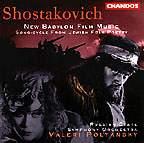 Shostakovich’s 25-minute song cycle From
Jewish Folk Poetry (1948) is one of his most haunting works
for voice. It had to wait until Stalin was dead for its first
performance (1964). Rich and colorful orchestration supports
plaintive texts bemoaning poverty, hunger, persecution, loneliness
and grief. Haitink’s 1983 recording with the Concertgebouw
(London/Decca) remains the classic. The Concertgebouw Orchestra
(especially the strings) has a richer more reverberant sound.
Haitink also takes the eleven songs much slower. His three
soloists use their big operatic voices for maximum emotional
effect: Elizabeth Söderström and Ortrun Wenkel are not afraid to
keen and wail. The Russian State Symphony, recorded in Moscow
1996, has a cleaner, more chamberish sound, reflecting Chandos’s
"honest" engineering policy. Polyanski’s singers are fresh,
youthful and well-matched (the tenor is better than Haitink’s).
Being Russian, their interpretations are idiomatic but slightly
inhibited. Chandos couples Op. 79 with 44 minutes of
Shostakovich’s music for the1929 silent movie New Babylon.
Without the movie to watch, it is hard to get enthusiastic about
this kinetic, occasionally touching, pastiche of political
anthems, lacrimose adagios and dance-hall tunes. Shostakovich’s 25-minute song cycle From
Jewish Folk Poetry (1948) is one of his most haunting works
for voice. It had to wait until Stalin was dead for its first
performance (1964). Rich and colorful orchestration supports
plaintive texts bemoaning poverty, hunger, persecution, loneliness
and grief. Haitink’s 1983 recording with the Concertgebouw
(London/Decca) remains the classic. The Concertgebouw Orchestra
(especially the strings) has a richer more reverberant sound.
Haitink also takes the eleven songs much slower. His three
soloists use their big operatic voices for maximum emotional
effect: Elizabeth Söderström and Ortrun Wenkel are not afraid to
keen and wail. The Russian State Symphony, recorded in Moscow
1996, has a cleaner, more chamberish sound, reflecting Chandos’s
"honest" engineering policy. Polyanski’s singers are fresh,
youthful and well-matched (the tenor is better than Haitink’s).
Being Russian, their interpretations are idiomatic but slightly
inhibited. Chandos couples Op. 79 with 44 minutes of
Shostakovich’s music for the1929 silent movie New Babylon.
Without the movie to watch, it is hard to get enthusiastic about
this kinetic, occasionally touching, pastiche of political
anthems, lacrimose adagios and dance-hall tunes.
-
-
- To the Soul (Songs to the Poetry of
Walt Whitman)
- Thomas Hampson, baritone / Craig Rutenberg,
piano
- EMI 55028
-
-
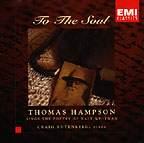 This interesting album of songs set to the
poetry of Walt Whitman by eighteen composers (most of them
post-World War II Americans) is a valuable by-product of EMI’s
Thomas Hampson Year (1997). Hampson deserves credit for
co-piloting this project, and his singing is remarkably engaged.
Only in the loudest passages does he sound a bit tired. Most of
these settings are pedestrian, sterile experiments (Michael Tilson
Thomas’s pathetically campy "We Two Boys Together Clinging"), like
the vast majority of contemporary art songs. But there are a
couple of gems: Burleigh’s "Ethiopia Saluting the Colors," Charles
Naginski’s eerie "Look Down Fair Moon," and Craig Urquhart’s
deeply felt gay anthem "Among the Multitude." Considering the
overwhelmingly homoerotic nature of these songs (and the
orientation of the composers, one assumes), it is sad that EMI’s
notes never mention sexuality, preferring unwhitmanesque
euphemisms, like referring to Leonard Bernstein’s "psychological
contraries" (sic) without telling us that in his fifties Bernstein
left his wife and children to live with another man. This interesting album of songs set to the
poetry of Walt Whitman by eighteen composers (most of them
post-World War II Americans) is a valuable by-product of EMI’s
Thomas Hampson Year (1997). Hampson deserves credit for
co-piloting this project, and his singing is remarkably engaged.
Only in the loudest passages does he sound a bit tired. Most of
these settings are pedestrian, sterile experiments (Michael Tilson
Thomas’s pathetically campy "We Two Boys Together Clinging"), like
the vast majority of contemporary art songs. But there are a
couple of gems: Burleigh’s "Ethiopia Saluting the Colors," Charles
Naginski’s eerie "Look Down Fair Moon," and Craig Urquhart’s
deeply felt gay anthem "Among the Multitude." Considering the
overwhelmingly homoerotic nature of these songs (and the
orientation of the composers, one assumes), it is sad that EMI’s
notes never mention sexuality, preferring unwhitmanesque
euphemisms, like referring to Leonard Bernstein’s "psychological
contraries" (sic) without telling us that in his fifties Bernstein
left his wife and children to live with another man.
-
-
- Leos Janácek: String Quartets No. 1
& No. 2
- Prazak Quartet
- Praga PRD 250 108 / SRI
-
-
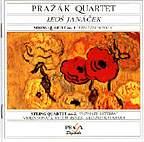 This recording of Janácek’s two delicious
string quartets takes its place among the best of the dozen-plus
versions in the catalogue. Janácek’s String Quartet No. 1,
inspired by Tolstoy’s novella The Kreuzer Sonata, is a
dramatic work full of Janácek’s typical picturesque local colour
and tragicomic sensibility. It is one of the masterpieces of
programmatic writing, vividly re-enacting the harrowing novella’s
tale of adultery and murder. The Czechoslovakian Prazak Quartet
are masters of Janácek’s atmospheric string effects so often sadly
flubbed by western ensembles. Despite recorded sound that is
slightly fuzzy and over-reverberant (typical, alas, of many Prague
recordings) this is a highly recommended disc. It firmly beats
Sony’s recent release of the same works by the Julliard Quartet
(SK 66840) recorded in 1989 (No. 2) and 1995 (No.
1). The Julliard play with a coarseness and vehemence that
can’t disguise their lack of affinity for Janácek’s
psychologically subtle art. Move right on to the Vlach Quartet
(Naxos 8.553895) for better music at half the price (but beware, a
bar is missing from the second quartet, according to the April
1998 Gramophone magazine) . This recording of Janácek’s two delicious
string quartets takes its place among the best of the dozen-plus
versions in the catalogue. Janácek’s String Quartet No. 1,
inspired by Tolstoy’s novella The Kreuzer Sonata, is a
dramatic work full of Janácek’s typical picturesque local colour
and tragicomic sensibility. It is one of the masterpieces of
programmatic writing, vividly re-enacting the harrowing novella’s
tale of adultery and murder. The Czechoslovakian Prazak Quartet
are masters of Janácek’s atmospheric string effects so often sadly
flubbed by western ensembles. Despite recorded sound that is
slightly fuzzy and over-reverberant (typical, alas, of many Prague
recordings) this is a highly recommended disc. It firmly beats
Sony’s recent release of the same works by the Julliard Quartet
(SK 66840) recorded in 1989 (No. 2) and 1995 (No.
1). The Julliard play with a coarseness and vehemence that
can’t disguise their lack of affinity for Janácek’s
psychologically subtle art. Move right on to the Vlach Quartet
(Naxos 8.553895) for better music at half the price (but beware, a
bar is missing from the second quartet, according to the April
1998 Gramophone magazine) .
-
-
- Stewart Wallace: Harvey
Milk
- Donald Runnicles/San Francisco Opera
Orchestra
- (Teldec 0630-15856-2/ Warner)
-
-
- This bio-musical of the life and death of gay San Francisco
city supervisor Harvey Milk is another quasi-artistic attempt to
exorcise America’s political and moral demons. Michael Korie’s
libretto cobbles together the most tired clichés about Jewish
life, gay life, and political activism. All the main characters
spout fatuous Broadway-style monologues at the expense of dramatic
development. The music is a facile "Name That Tune" pastiche of
Wagner, Menotti, Richard Strauss, Leonard Bernstein and Philip
Glass. Whatever the entertainment value of the original stage
production seen in Houston, New York and San Francisco, this
recording makes for an embarrassing listening experience.
-
- Albert Lortzing: Die
Opernprobe
- Otmar Suitner / Chor & Orchester der
Bayerischen Staatsoper München
- Naxos CPO 999 557-2
Les opéras de veine comique d'Albert Lortzing (1801-1851),
extrêmement populaires dans son Allemagne natale, sont fort peu
joués à l'étranger. La raison en est que l'humour allemand est
généralement méconnu, au point où certains iront même jusqu'à nier
son existence ou, pis encore, à le taxer de mauvais goût. En
réalité, le comique allemand existe bel et bien et peut être subtil,
mais c'est un humour essentiellement parodique et caricatural,
relativement peu porté sur les complications dramatiques et qui,
surtout, lorsqu'il est centré sur le langage, tourne moins sur les
mots eux-mêmes que sur le ton du discours. À l'opéra,
particulièrement sensible à ce dernier aspect, on songera avant tout
aux Meistersinger de Wagner ou aux comédies de Richard
Strauss. Mais ceux-ci ont eu des prédécesseurs, dont Lortzing
(auteur d'un Hans Sachs!) est certainement l'un des plus
importants.
Die Opernprobe (La répétition d'opéra) occupe une position
particulière à l'intérieur de sa production, parce que, dans ce
court Singspiel (comédie musicale avec dialogues parlés)
l'humour prend l'opéra lui-même pour cible. On y voit un noble de
province qui s'est tellement entiché d'art lyrique qu'il ne
s'exprime plus qu'en récitatifs et qu'il a décidé de transformer sa
maison en une compagnie d'opéra. Lortzing s'amuse aux dépens de
l'opera seria de la fin du 18e siècle en une suite de numéros
parodiques, ensembles et récitatifs accompagnés. Après un prélude
enjoué, version orchestrale de la musique d'un de ces ensembles, le
rideau se lève sur une scène d'un comique irrésistible, sans doute
la meilleure de l'oeuvre où l'on entend l'orchestre des serviteurs
du château répéter une ouverture sous la direction de leur chef
attitré --- qui n'est autre que la femme de chambre de Madame la
comtesse!
Die Opernprobe offre également un exemple du style musical
le plus mûr de Lortzing, dont c'est la toute dernière oeuvre, sa
création ayant eu lieu seulement quelques heures avant la mort du
compositeur. À écouter cette musique, toujours élégante,
lumineusement orchestrée et qui sied magnifiquement aux voix, on
s'aperçoit immédiatement que Lortzing a appris son métier en
cultivant les grandes partitions de Mozart. Mais il est également
allé puiser à d'autres sources, populaires et romantiques, pour se
forger un langage en fin de compte personnel, qui annonce le style
léger de l'opérette viennoise.
L'enregistrement (datant de 1974), d'excellente qualité
technique, est le seul actuellement disponible en CD et il est peu
probable que cette partition soit jamais mieux servie que par cette
belle équipe de chanteurs (Marheineke, Gedda, Berry) et l'orchestre
du Staatsoper de Munich, dirigé par Otmar Suitner. L'absence
regrettable de livret n'est pas vraiment compensée par la présence
d'un sommaire détaillé. Pierre Marc Bellemare
|


